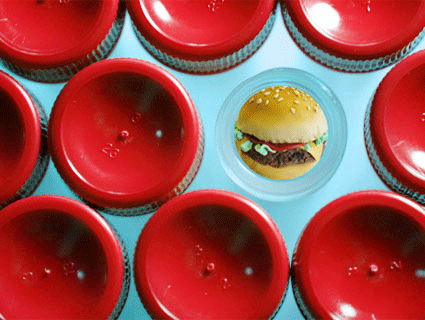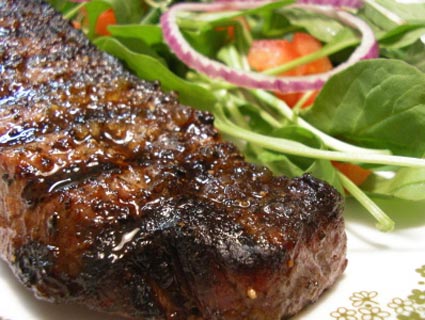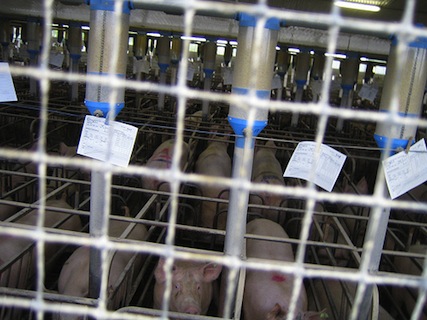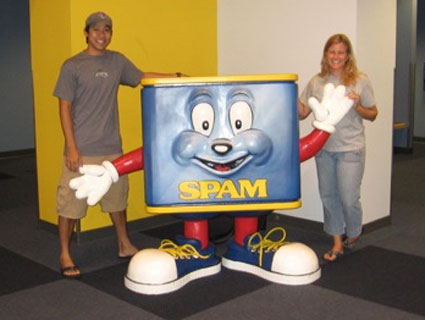
<a href="/authors/celine-nadeau">Celine Nadeau</a>, with <a href="http://www.flickr.com/photos/heypaul/107326169/sizes/o/in/photostream/">jordan_lloyd</a> and <a href="http://www.flickr.com/photos/gorillasushi/3646219431/sizes/l/in/photostream/">GorillaSushi</a>/Flickr
Would you eat a hamburger that was grown in a test tube? How about a chicken nugget from a petri dish? Sometimes called “shmeat” (as in, a sheet of lab-grown meat), in vitro meat might someday be an option for people with carnivorous inclinations who aren’t wild about the idea of killing and eating real animals.
Although scientists have been kicking around the idea of synthetic meat for about a decade, they haven’t yet been able to bring it to market, much less mass-produce it. But they’re getting closer: Last week, Chalmers University of Technology in Sweden and the European Science Foundation held a workshop to discuss the future of test-tube meat and to develop an “action plan” to get fake meat to market. The conference brought together tissue engineers, as well as environmental scientists, ethicists, social scientists, and economists.
So far, the largest group of meat cells that scientists have been able to grow is only about 2.5 centimeters long and 0.7 centimeters wide, though some scientists are predicting that we could have lab-grown sausage in as little as six months, as TreeHugger reported recently. To make the stuff, tissue engineers take stem cells from an animal and place them in a nutrient-rich culture, where they can multiply into something resembling muscle tissue. It used to be that they had to use animal products to create that nutrient mixture (like animal blood), but now researchers have discovered a viable non-animal option that uses sunlight and carbon dioxide, much like photosynthesis, to grow the tissue. (The meat-substitute advocacy group New Harvest has a handy FAQ, if you’re interested in learning more.)
But the researchers note that mass-marketed test-tube meat is still a ways off. The biggest challenge is a lack of funding for research. And despite the recent scientific progress, it’s still very expensive to produce the fake meat, and it can’t be done in large quantities, which means it’s nowhere near cost-competitive with meat that comes from actual animals. A recent report estimated that the first in vitro burger could cost nearly half a million dollars.
NPR offered a good explanation of the challenges facing in vitro meat earlier this year, noting that you have to give the muscle cells a workout in order for this to be feasible—sort of like taking your fake meat to the gym:
Muscles require stimulation and exercise or they will atrophy and die. Scientists currently use electrical impulses to stimulate the muscle cells grown in the laboratory, but haven’t yet figured out how to do it on a mass-factory scale.
“If you’re growing it in a factory, [there’s a mass] quantity of meat,” Specter says. “It’s difficult to see our way to zapping tons of electricity into muscle cells, because it will just be, if nothing else, extremely costly. So while that works in a lab and it works well, they are looking at other ways of doing it.”
Plus it will require rigorous testing before it can be fed it to humans; it’s still such a new idea that we don’t really know yet what, if any, health concerns it might yield. Right now there are no regulatory guidelines for in vitro meats.
Still, the workshop participants outline a number of good arguments in favor of shmeat. As the world population increases, so does per capita meat consumption, especially in places like China, where people are rapidly becoming more affluent. If the current rate of increase in meat consumption continues, the Food and Agriculture Organization of the United Nations predicts that it will double between 2000 and 2050. That’s a whole lot of meat.
Fake meat could also help address a whole host of environmental concerns. We wouldn’t need to use as much land for agriculture (both for raising livestock and for growing their feed). We wouldn’t have to use all the water that meat production requires, or the pesticides, hormones, or other problematic additives so common in industrial agriculture.
Indeed, a recent study from Oxford University and the University of Amsterdam found that, when compared to regular beef, synthetic meat would:
- Use 45 percent less energy overall
- Create 96 percent less greenhouse gas emissions
- Require 99 percent less land
- Use 96 percent less water
And we could reduce the threat of animal-to-human diseases, like bird flu, E. coli, and salmonella. It would also be possible to control things like the fat, cholesterol, or calorie content of a synthetic-meat product.
Mad scientists aren’t the only ones stoked about the potential for fake meat. PETA is offering a $1 million reward to whomever can produce in vitro chicken meat and make it commercially viable by June 30, 2012 (a contest that apparently almost started a civil war within the organization). That contest has been running for nearly three years, though, and it doesn’t look anyone is poised to claim the prize yet.
Therein seems to lie the problem, both for the scientists who organized last week’s shmeat summit and the PETA folks: While you can come up with a million good reasons for it, you’d still have to convince people to eat it. There seems to be a considerable “ick” factor when it comes to test-tube meat. I mean, don’t get me wrong—eating real meat also grosses me out if I think about it too much. After nearly a decade as a vegetarian, I now eat meat occasionally, even though I still realize I shouldn’t. (Did you see the New York Times piece over the weekend about the stuff they’ve found in hot dogs? Maggots, worms, metal, plastic, a razor…) But eating test-tube meat somehow manages to freak me out even more. It might be irrational, but I can’t find anything remotely appealing about eating a meat-like substance grown in a test tube.
Then again, I know plenty of carnivores who feel guilty about eating meat but don’t know how to stop. They like the way it tastes; they don’t feel full without eating it; it’s too hard to eat a balanced diet without it; etc. So maybe this could be the solution for them. What say you, Blue Marble readers? Is shmeat neat, or not so much?














